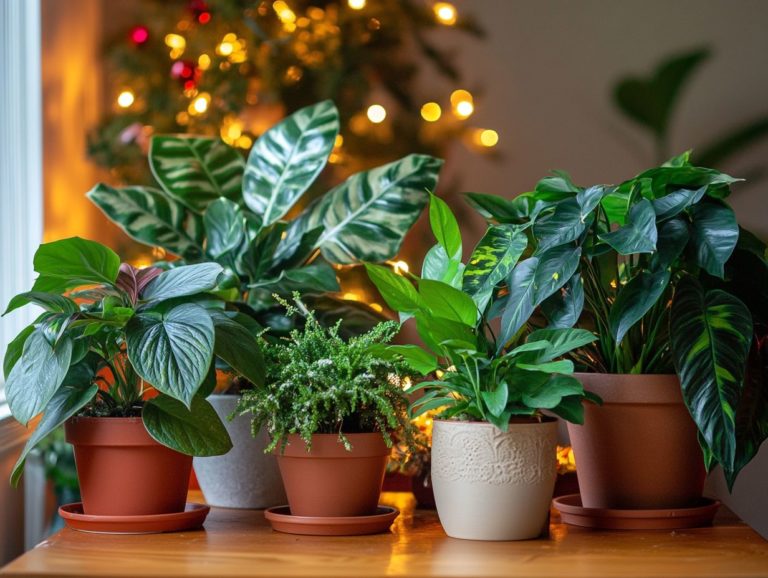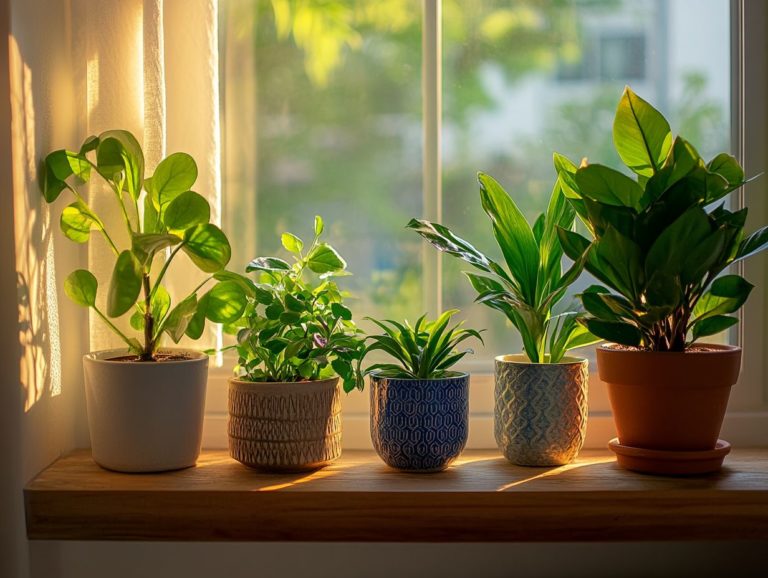How to Grow Chinese Money Plants Indoors
Chinese Money Plants, or Pilea Peperomioides, have undoubtedly won the hearts of plant lovers everywhere with their delightful round leaves and low-maintenance charm.
In this article, you ll discover the many benefits of nurturing these vibrant plants indoors, from their remarkable air-purifying properties to their eye-catching appearance.
Get ready to unlock the secrets to making your Chinese Money Plants thrive! You ll learn how to select the ideal pot and soil, understand their light and temperature preferences, master effective watering techniques, and discover how to propagate them. Plus, you ll find strategies to tackle pesky common pests.
Contents
Key Takeaways:
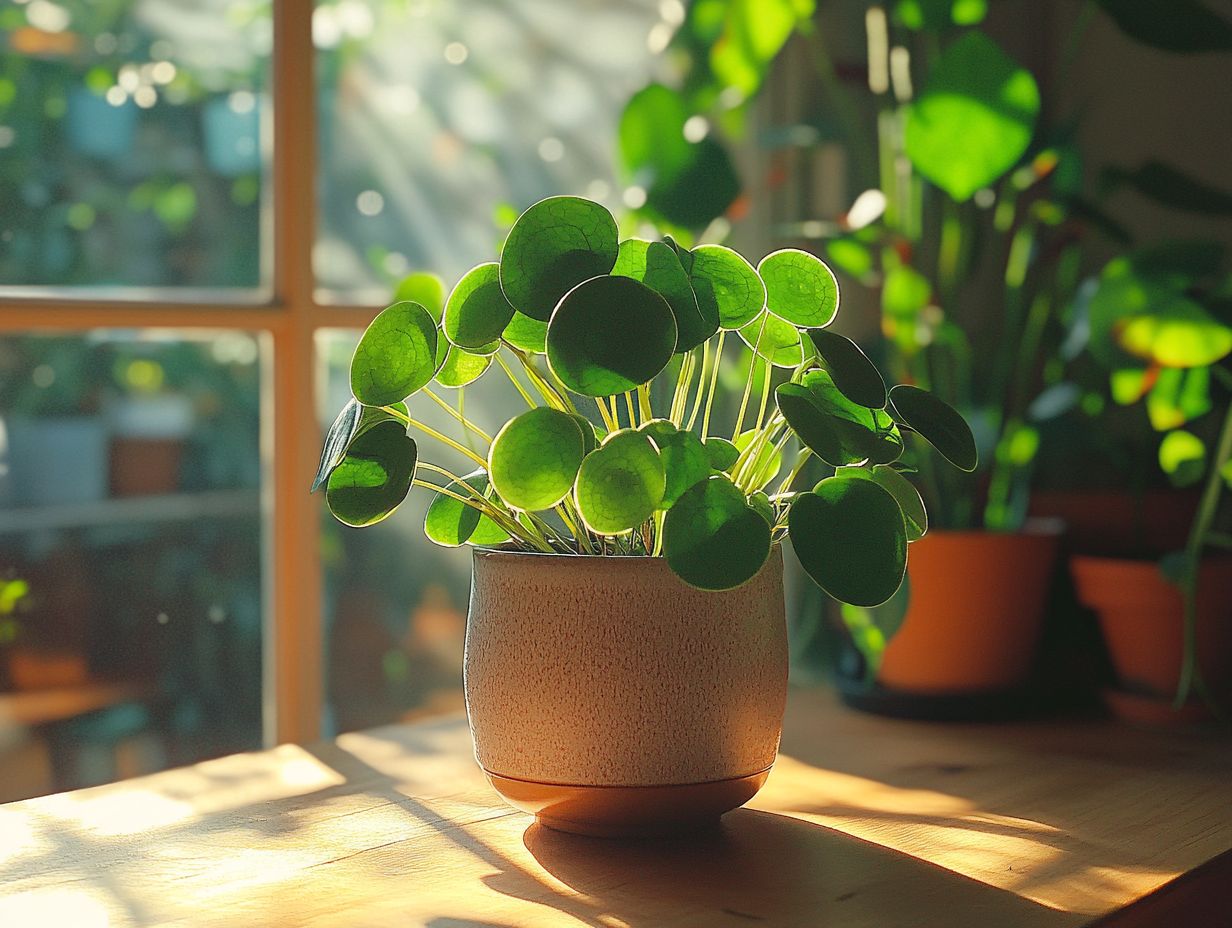
- Chinese Money Plants are low-maintenance and can improve indoor air quality while adding a touch of green to your space.
- Choosing the right pot and soil is crucial for the health and growth of Chinese Money Plants. Consider factors such as drainage and moisture retention when selecting materials.
- Chinese Money Plants thrive in bright, indirect light and moderate temperatures. Proper watering and fertilizing techniques are also important for their growth and development.
What are Chinese Money Plants?
Chinese Money Plants, or Pilea Peperomioides, have become the darlings of indoor gardening. With their striking round leaves and low maintenance needs, it s no wonder they ve captured the hearts of so many.
Originating from Southern China, these delightful plants go by various nicknames, such as Pancake Plants, UFO Plants, or Missionary Plants, all thanks to their unique leaf shape and intriguing backstory. They are said to have made their way to Europe through missionaries, earning the name “Missionary Plant.” In many cultures, they symbolize prosperity and good luck, making them popular gifts for friends and family a charming way to spread affection.
These resilient beauties thrive in bright, indirect light and need minimal watering, making them perfect for indoor spaces, even for beginners. Their popularity is soaring, especially in urban environments, where they provide a refreshing touch of nature amid the hustle and bustle of city life.
Benefits of Growing Chinese Money Plants Indoors
Growing Chinese Money Plants indoors presents many advantages that go far beyond their visual appeal. These hardy plants not only purify the air but also elevate the overall ambiance of your space. Their low-maintenance needs make them perfect for both beginners and experienced plant lovers, thriving effortlessly in a variety of indoor settings.
Air Purification and Aesthetic Appeal
Chinese Money Plants elevate the aesthetic of your indoor space while also contributing significantly to air purification, enhancing the overall quality of your environment. Their lush green leaves brighten up any room, making them a chic addition to your interior decor.
These plants effectively filter out common indoor pollutants, helping cultivate a healthier living space. Their distinctive round leaves and compact growth pattern fit beautifully with various design styles, whether you lean towards minimalist or bohemian aesthetics.
To effortlessly incorporate these plants into your home or office, consider placing them on shelves, desks, or windowsills, where their vibrant presence can be enjoyed every day. Grouping several together can create a striking focal point, while their low-maintenance nature makes them perfect for both seasoned plant lovers and those just starting out.
Choosing the Right Pot and Soil
Selecting the right pot and soil is essential for the health and vitality of your Chinese Money Plant (Pilea Peperomioides). A terracotta pot can be advantageous, as it helps regulate moisture within the soil, effectively mitigating the risk of root rot caused by overwatering.
Factors to Consider
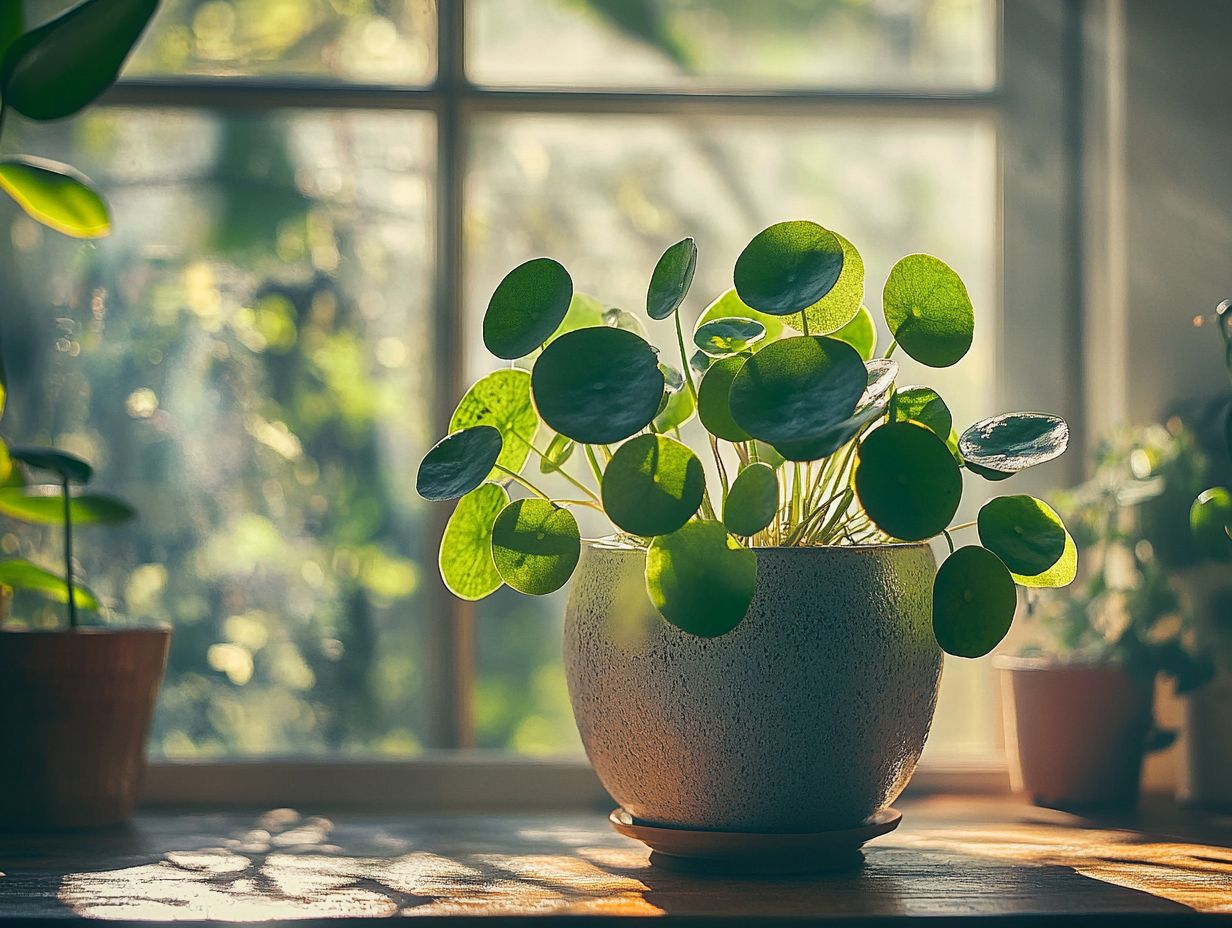
When potting your Chinese Money Plant, consider several key factors. These include the pot’s size, the type of soil, and the plant’s light requirements.
Ensuring your plant receives indirect sunlight is essential for thriving. This helps maintain that vibrant appearance you desire.
Selecting the right pot size is crucial. It allows for adequate root growth while avoiding the overwhelm of a container that’s too large.
Ideally, a pot just one size larger than the current one strikes the perfect balance.
For the soil composition, use a well-draining mix. A blend of potting soil, perlite, or orchid bark helps prevent excess water in the soil.
Light conditions matter too. These plants prefer bright, indirect light, but they can adapt to lower light scenarios. This makes them versatile for various indoor spaces.
Don’t forget to rotate your plant periodically. This ensures even growth and helps it avoid leaning toward the light source.
Light and Temperature Requirements
Understanding the light and temperature needs of your Pilea Peperomioides is crucial for its growth and vitality. These delightful plants flourish in bright, indirect sunlight, making them perfect for many indoor settings.
Keep the temperature between 60 F and 75 F. This helps ensure your Pilea remains in optimal health.
Optimal Conditions for Growth
To achieve optimal growth for your Chinese Money Plant, create ideal conditions. This includes proper light and humidity levels to enhance the plant’s overall health.
Maintaining a humid environment, especially during the dry winter months, significantly boosts the vitality and growth of your Pilea.
Bright, indirect sunlight is essential. Too much direct exposure can scorch the leaves, while insufficient light leads to unfortunate leggy growth.
Position your plant near a window with filtered light for the best results.
Consider using a pebble tray or a humidifier to effectively increase humidity levels, especially if you live in a drier climate.
It’s vital to keep an eye on indoor temperatures. Your Pilea thrives best in a range of 65-75 F (18-24 C).
Avoid drafty areas and maintain a stable temperature. This will prevent stress and nurture a flourishing environment for your plant to thrive.
Watering and Fertilizing
Effective watering and fertilizing are essential for your Chinese Money Plant (Pilea Peperomioides). These practices ensure it thrives in vibrant health.
By understanding soil moisture levels, you can establish the ideal watering schedule. Regular fertilization during the growing season encourages robust growth.
Proper Techniques for Nourishment
Employing the right techniques for watering and fertilizing is crucial for your plant’s nourishment and overall health. Check soil moisture levels to determine the perfect time to water.
Selecting the appropriate fertilizer ensures your Pilea receives the nutrients it needs.
For optimal results, try the finger test to check soil moisture. Insert your finger about an inch deep into the soil and feel for moisture. If it s dry, it s time to give your plant a drink.
In terms of fertilization, use a balanced liquid fertilizer diluted to half strength. This will provide necessary nutrients without overwhelming your plant.
Timing is also vital fertilize during the growing season, typically spring and summer, every four to six weeks to support robust growth.
Regularly monitoring both water and nutrient levels will ensure your Pilea thrives beautifully in your home.
Propagation and Repotting

Propagation and repotting are essential for nurturing your Chinese Money Plant (Pilea Peperomioides). This is especially important as it starts to produce those charming Pilea pups.
Understanding the art of propagation enables you to grow your collection. It also significantly enhances the overall vitality of the main plant.
How to Expand Your Plant Collection
Expanding your plant collection by propagating your Chinese Money Plant can be an incredibly rewarding and enjoyable journey. By skillfully separating Pilea pups and nurturing them, you can create new plants that enhance your indoor plant landscape.
This practice not only enriches your collection but also helps the original plant thrive, promoting healthier growth. To get started, wait until the pups are a few inches tall and have developed their own set of leaves, usually during the growing season. Gently separate the pups from the main plant, taking care to avoid damaging their delicate roots.
Prepare small pots with well-draining potting soil. Plant each pup at the same depth they grew. A light watering will suffice. Place them in a bright spot with indirect sunlight. Consistent care, like occasional watering and pest monitoring, will help the pups establish strong roots.
As they grow, you’ll enjoy watching them thrive!
Common Pests and Diseases
Understanding common pests and diseases affecting your Chinese Money Plant (Pilea Peperomioides) is essential for preserving its health and vibrancy. By regularly observing your plant, you empower yourself to detect potential issues early on, helping you manage pests and prevent diseases.
Identifying and addressing issues related to pests and diseases is crucial for the longevity of your Chinese Money Plant. By recognizing the signs of infestations or illnesses, you can swiftly take action.
Common pests like spider mites and mealybugs often target Pilea plants, showing up as discolored or wilting leaves. Spider mites, for example, leave behind tiny webs on the undersides of the foliage, while mealybugs appear as cotton-like clusters. To combat these unwelcome guests, a simple mixture of water and mild soap can work wonders. Regular misting will help maintain humidity.
Diseases such as root rot, often caused by overwatering, can severely compromise your plant’s health. It’s essential to monitor soil moisture and ensure proper drainage. Taking preventive steps, like routine checks and maintaining optimal light and humidity levels, will help keep your Pilea flourishing.
Watch this helpful video on how to care for your Chinese Money Plant.
Frequently Asked Questions
What is a Chinese Money Plant and how do I grow it indoors?
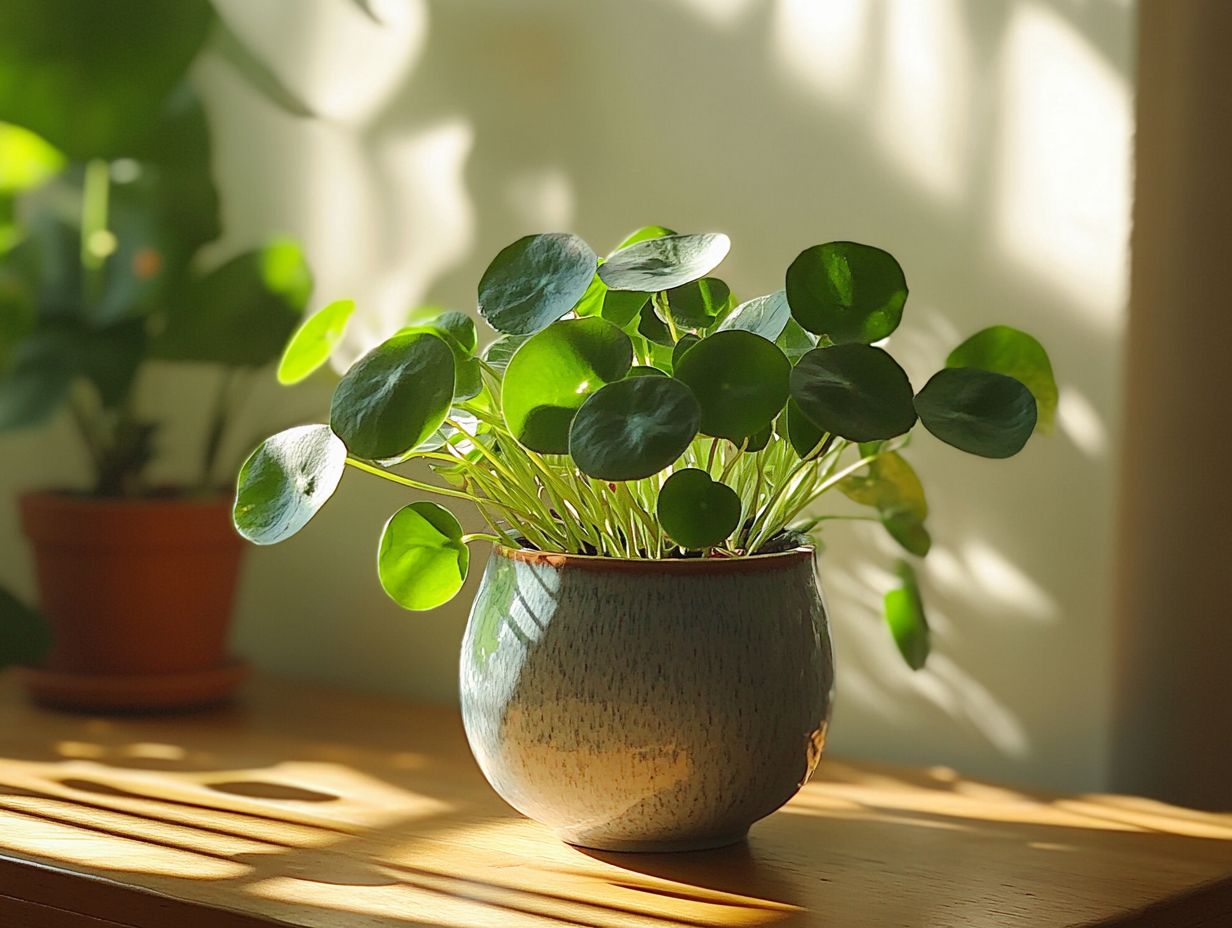
A Chinese Money Plant, also known as Pilea peperomioides, is a popular houseplant known for its round, coin-shaped leaves. To grow it indoors, place it in a well-draining pot with rich, well-aerated soil and provide it with bright, indirect sunlight.
Where should I place my Chinese Money Plant indoors?
Chinese Money Plants thrive in bright, indirect sunlight. Place them near a window that receives plenty of natural light, but avoid direct sunlight as it can scorch the leaves. You can also use artificial grow lights to provide adequate light for your plant.
How often should I water my Chinese Money Plant?
A Chinese Money Plant requires regular watering, but it’s important not to overwater it. Check the top inch of soil and water when it feels dry to the touch. Generally, this plant needs to be watered once or twice a week, depending on the temperature and humidity levels in your home.
Do I need to fertilize my Chinese Money Plant?
Fertilizing your Chinese Money Plant is not necessary, but it can help promote healthy growth. Use a well-balanced, water-soluble fertilizer once a month during the growing season. Make sure to dilute the fertilizer to half strength to avoid burning the plant’s roots.
How can I propagate my Chinese Money Plant?
Chinese Money Plants are easy to propagate, and it’s a great way to get more plants for your home. Simply take a stem cutting from an established plant and place it in a jar of water or directly in moist soil. Keep the cutting in a bright, warm location, and roots should start to develop in a few weeks.
What are your favorite tips for growing Chinese Money Plants? Share in the comments!
Are Chinese Money Plants Safe for Pets?
Yes, Chinese Money Plants are safe for pets. They won’t harm your cats, dogs, or other common household pets.
Always keep an eye on your pet’s behavior around houseplants. If you have other plants, make sure they are not harmful to your furry friends.




